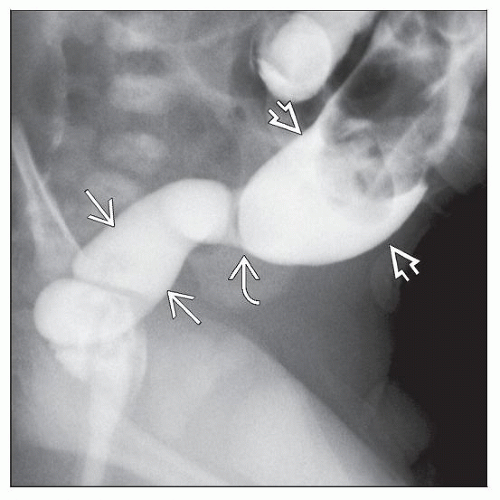Hirschsprung Disease
Alexandros D. Polydorides, MD, PhD
Key Facts
Terminology
Heterogeneous developmental disorder
Absent ganglion cells in distal large intestine
Etiology/Pathogenesis
Failure of neural crest cell migration (embryogenesis)
5-10% familial, RET most common gene mutated
Clinical Issues
Most common congenital intestinal obstruction
M:F = 4:1 in short-segment HD
Delayed meconium passage, abdominal distention, constipation, bilious vomiting, feeding intolerance
Enterocolitis in 10-30% of HD (especially with Down)
Decompress colon, stabilize/resuscitate patient 1st
Resect involved segment, restore bowel continuity
1-stage pull-through, intraoperative biopsies
Macroscopic Features
Distal narrowing, proximal dilatation
Long-segment HD (10-15%): Beyond splenic flexure
Total colonic aganglionosis (5-10%)
Microscopic Pathology
Complete lack of ganglion cells in submucosal and myenteric plexuses in narrowed bowel segment
Hypertrophy of Schwannian nerve elements
Diagnostic Checklist
Ganglion cell presence in colon biopsy rules out HD
Nerve hypertrophy suggestive of HD, not diagnostic
Multiple biopsies > 2 cm above dentate line
Enough submucosa; serial sections examined
Use neuronal markers (NSE) to identify ganglion cells
Acetylcholinesterase(+) thick nerve fibers
TERMINOLOGY
Abbreviations
Hirschsprung disease (HD)
Synonyms
Aganglionic (congenital) megacolon, congenital intestinal aganglionosis
Skip-segment HD = zonal colonic aganglionosis
Definitions
Heterogeneous group of developmental disorders involving enteric nervous system
Absent ganglion cells in myenteric (Auerbach) and submucosal (Meissner) plexuses of large intestine
Defective peristalsis, functional intestinal obstruction
ETIOLOGY/PATHOGENESIS
Developmental Anomaly
Failure of neuroblasts (neural crest-derived ganglion cell precursors) to migrate craniocaudally, colonize, or differentiate in distal bowel during embryogenesis
Earlier migration arrest → longer aganglionic segment
Complex (multifactorial) genetic disease
5-10% familial (more in long-segment HD)
Autosomal dominant, incomplete penetrance
Associated congenital anomalies (15-20% of cases)
Down syndrome, cardiac defects, neurofibromatosis, and other neural crest disorders (neurocristopathies)
If present, genetic counseling is recommended
Especially in long-segment HD
Classic HD: Usually sporadic anomaly
Rare acquired and adult forms have been described
Pathophysiology
Absent inhibitory components (e.g., nitric oxide) of peristaltic reflex (intrinsic enteric innervation)
Persistent extrinsic cholinergic/adrenergic innervation
Aganglionic segment under constant stimulation
Narrowed, spastic, chronically contracted
Unable to participate in peristalsis
Interstitial cells of Cajal: Represent intestinal pacemaker cells
Signal from enteric nerves to smooth muscle cells
Found to be reduced in aganglionic bowel segments
Genetics
Various genetic mutations identified (50% of cases)
RET protooncogene: Most common gene mutated
Particularly in long-segment HD (80% of cases)
Stay updated, free articles. Join our Telegram channel

Full access? Get Clinical Tree










